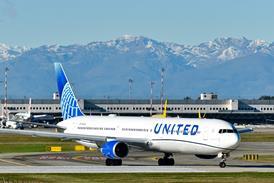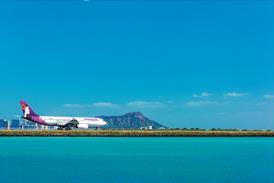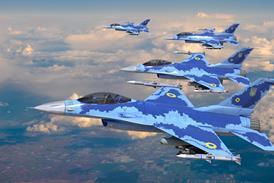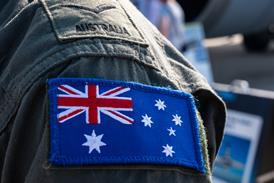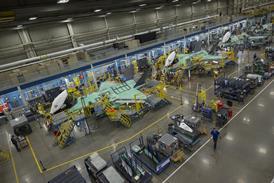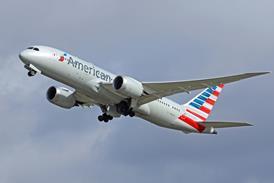Civil-engine discussion at Le Bourget will be overshadowed by the big-twin power struggle.
Guy Norris/LOS ANGELES
Big engines, mergers and the first hints of new orders will dominate the chalet gossip at Paris this year. The top end of the power battle will be represented by the looming presence of the Boeing 777, and its huge Pratt & Whitney PW4084 power plants, which will appear in the static display there for the first time.
Compared to 1994, when much of the focus at Farnborough was on the small and mid-thrust arena, Paris will therefore see a swing back to concentrate on the high-thrust bracket. While no-one is assuming a sudden boom in new wide-body orders, there will be plenty of delicate manoeuvring as manufacturers posture themselves for a slow, but steady market revival.
P&W will certainly appear to be in the driving seat, with revenue-earning PW4000 series engines in commercial service on both of the new giant twins - the Airbus A330 and the Boeing 777. With its PW4084 teething problems seemingly over, the company is anxious to capitalise on its early lead on the 777, and will be detailing design efforts for a proposed PW4098 version aimed at the stretched 777-300X and other heavyweight versions.
The prospect of a shorter-bodied 777-100X could also stimulate the market for engine makers, which need to see more openings for returns on their massive investment. Boeing's proposed weight limits for this long-range airliner mean that all three engine makers, have suitable power plants already under development. The -100X opens up new niches for the 777, with potential operators such as SIA (already pencilled in as a -200 user), Qantas and American Airlines among others.
General Electric hopes to gain more momentum, having prepared for its early extended-range twin operations (ETOPS) GE90/777 plan by flying its second British Airways aircraft in mid-May. With the temporary hiccup of a test-flight surge already a distant memory, the company is back on track for entry-into-service with BA in September at a certificated thrust level of 380kN (85,500lb).
GE believes that its giant GE90 is better suited the heavier the aircraft becomes, and emphasises the engine's expected operational advantages in hot and high conditions. It will certify the next growth stage of the engine, the 410kN GE90-92B, in May 1996, in preparation for the first BA "B"-market 777 delivery in December 1996. British Airways will operate the engine at the slightly de-rated level of 400kN.
The Rolls-Royce Trent 800 is quickly catching up in the 777 race, having achieved initial certification at a higher thrust (400kN), than either of its US counterparts. In schedule terms, it pipped GE at the certification post, and officially began its test programme before the PW4084 entered service. Even the company's recurring epistle on the merits of the three-shaft design seems to be gaining more credibility in the international sales arena. All Rolls Royce needs now is more sales, as do all the engine makers.
With the engine maker's eggs firmly in the big-thrust basket, there is likely to be less discussion about any new mid-thrust developments. Airbus, for example, has indicated that A330 and A340 developments linked to a new, 180kN-class engine are definitely on the back burner.
What talk there will be about the more mature widebody engines will almost certainly be led by GE, and its efforts to enhance the CF6. This is spearheaded by the company's "technology-stocking" initiative, which was largely inspired by the frustrations of keeping in-line with the quickly growing A330 thrust requirement.
Using technology stocking, GE is developing discrete advanced components which will be brought off the shelf, and used to meet new power requirements at a fraction of the cost and time of previous developments. GE believes that the low nitrous oxides (Nox) emissions combustor, which is being developed under the initiative, helped clinch the United Parcel Service's Boeing 767-300ER freighter order against stiff competition from P&W and R-R. The new combustor will enter service in October on the first UPS 767, and was incorporated very quickly into the CF6 programme.
Retrofit kits will be available from early 1996, and all production engines will have them as standard from January 1996 onwards. The programme carries significant money-earning potential, particularly in the CF6-80C2 retrofit market. The 233-273kN range family now powers more than 635 Airbus A300s, A310s, Boeing 747s, 767s and McDonnell Douglas MD-11s.
Another example of technology stocking is a new pressure-turbine (HPT) rotor, which will be certificated in 1996 for the CF6-80E1. Advanced cooling techniques, imported from the CFM56, will produce a -6¡C cooling around the first-stage HPT blades. This will be turned into thrust growth or better efficiency, depending on the need. Again, the key as far as GE is concerned is the marketing leverage, which will be gained by this increased flexible response.
The beefed-up CF6-80E1 will be offered for a 230t Airbus A330, which GE believes will materialise after 1998. P&W is, meanwhile, studying growth options for the PW4168, and in April demonstrated the capability to reach 335kN, while actually powering the A330 - the first manufacturer to do so. The PW4168 is the first growth model of the PW4000 family. The test, which involved high angle-of-attack manoeuvres and a 10min take-off sequence at 335kN, gave P&W confidence that its engine has plenty of margin for future growth. R-R, whose first Trent 700-powered A330 entered service with Cathay Pacific in February, is also confident that the Trent has considerable growth margin.
All three are aware that this family is well worth paying attention to, not only because of the A330 sales potential, but also because the thrust category could be ideally suited to a future large aircraft. Plenty of talk will concern the future, if any, of the very large commercial transport (VLCT) study between Boeing and the Airbus partners. More serious attention may well be paid to Boeing's New Large Airplane and the Airbus A3XX.
In the lighter-thrust categories, battle continues between CFM International and International Aero Engines (IAE), and both are gearing up for competitions which some predict could total more than 3,500 engines in the narrow-body category over the next 20 years. Safely aboard the Boeing 737-600/700 and -800 family, CFMI has made the first run of the CFM56-7, and is confident of securing the majority of Airbus narrowbody sales in the near future.
IAE, on the other hand, continues to see a small, but steady, flow of V2500-powered A319, A320 and A321 orders, including its first important breakthrough into China. The company was also able to celebrate the entry into service of the V2500-powered MDC MD-90 with Delta Air Lines earlier in 1995, and is optimistic that the twinjet may help it clinch a part of the elusive Saudia order.
As confusion reigns in the 80-90kN arena, engine makers are still positioning themselves. As Paris approaches, it seems certain that MTU, long-time partner with P&W on its variously known RTF180, Project Blue and New Small Engine family, is about to defect to the BMW R-R BR.700 camp. Market analysis tentatively hints at a requirement for around 4,000 engines in this category by around 2015, but the continued uncertainties of Boeing's New Small Airplane study and the yet-to-launched BR.700-powered MD-95 do nothing to confirm this.
P&W is, meanwhile, still enjoying the fruits of its ubiquitous JT8D, some 14,000 of which were sold, making it the best-selling jet engine in history. It is closely involved with the various hushkit manufacturers working on almost 1,600 Stage 1 and 2 candidate aircraft. The operators of more than half of these have already either committed to hushkitting or have had their engines modified.
Fluctuating fortunes, in the lower 60-80kN power battle also, cloud the crystal ball in the regional-jet category. GE's success with the selection of the CF34-8C for the Canadair CRJ-X regional airliner may have dented the early ambitions of AlliedSignal's new AS800/900 Common Core development, but all eyes remain fixed on the ATR 82, and its possible shift to turbofan power. GE plans to make the first run of the CF34-8C core around the end of 1995, and may give further details at the show of plans to develop an entirely new family of engines in the 60-80kN thrust class from this base.
Allison, now part of the R-R family, continues development of its AE3007-14 series and, after the disappointment of losing the CRJ-X competition, is concentrating efforts on aircraft such as the ATR 82, and is finally supplying the first units to Embraer for the EMB-145 regional jet. It is also well into initial deliveries of the AE3007 to Cessna for the Citation X business jet. Although Cessna recently announced, that certification would be deferred from August to November 1995, the first aircraft are still expected to be handed over, in April 1996.
R-R is enjoying some success with new sales of the Tay-powered Fokker 70 to new customers such as Alitalia and America West regional operator Mesa, and Tay deliveries continue to Gulfstream for the GIV and to Dee Howard for the United Parcel Service 727-100QF conversion. The association with Gulfstream, meanwhile, continues with the build-up towards the first flight of the BR.700-powered Global Express.
AlliedSignal's growth ambitions with AS800 turboprop versions of the Common Core concept (inherited in 1994 with the acquisition of Textron Lycoming) will have to meet the continuing strength of GE's CT7 and P&W Canada's PW100 family. The PW150, for example, was selected in May over the AS800 and Allison AE2100 to power the de Havilland Dash 8-400 high-speed regional turboprop. The PW150 was also being offered for the ATR 82, but with the possible move to turbofan power, P&WC may be re-considering other options.
Paris, as usual, will no doubt provide the civil-propulsion community with as many new questions as it will answers.
Source: Flight International

